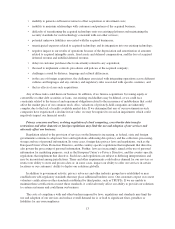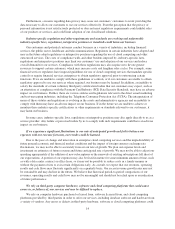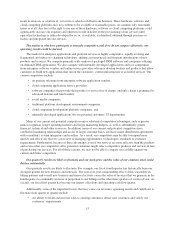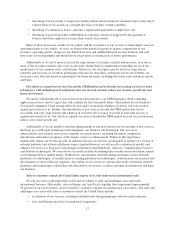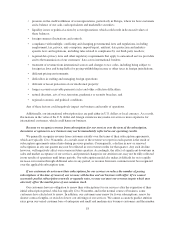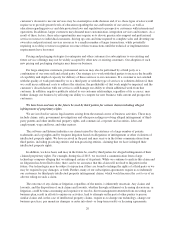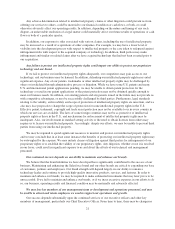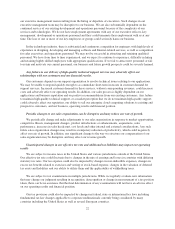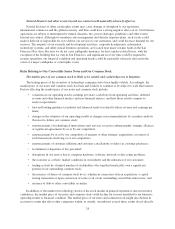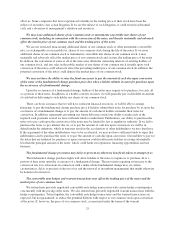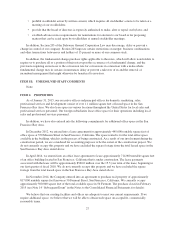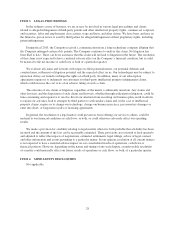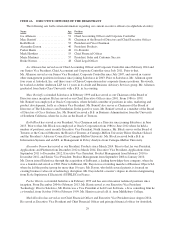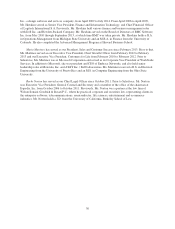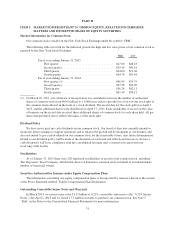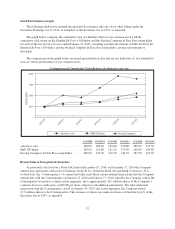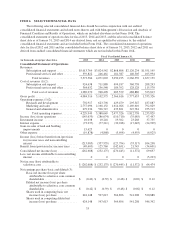Salesforce.com 2015 Annual Report Download - page 29
Download and view the complete annual report
Please find page 29 of the 2015 Salesforce.com annual report below. You can navigate through the pages in the report by either clicking on the pages listed below, or by using the keyword search tool below to find specific information within the annual report.Additionally, we may be subject to additional tax liabilities due to changes in non-income taxes resulting
from changes in federal, state or international tax laws, changes in taxing jurisdictions’ administrative
interpretations, decisions, policies, and positions, results of tax examinations, settlements or judicial decisions,
changes in accounting principles, changes to the business operations, including acquisitions, as well as the
evaluation of new information that results in a change to a tax position taken in a prior period.
Our debt service obligations and operating lease commitments may adversely affect our financial
condition and cash flows from operations.
We have a high level of debt, including our 0.25% Senior Notes due April 1, 2018, borrowings under our
revolving credit facility and capital lease arrangements. Additionally, we have significant contractual
commitments in operating lease arrangements, which are not reflected on our consolidated balance sheet. In
addition, we have a financing obligation for a leased facility of which we are deemed the owner for accounting
purposes. Our maintenance of this indebtedness could:
• impair our ability to obtain additional financing in the future for working capital, capital expenditures,
acquisitions, general corporate or other purposes;
• cause us to dedicate a substantial portion of our cash flows from operations towards debt service
obligations and principal repayments;
• make us more vulnerable to downturns in our business, our industry or the economy in general; and
• due to limitations within the revolving credit facility covenants, restrict our ability to incur additional
indebtedness, grant liens, merge or consolidate, dispose of assets, make investments, make
acquisitions, enter into transactions with affiliates, pay dividends or make distributions, repurchase
stock and enter into restrictive agreements, as defined in the credit agreement.
Our ability to meet our expenses and debt obligations will depend on our future performance, which will be
affected by financial, business, economic, regulatory and other factors. We will not be able to control many of
these factors, such as economic conditions and governmental regulations. Further, our operations may not
generate sufficient cash to enable us to service our debt. If we fail to make a payment on our debt, we could be in
default on such debt. If we are at any time unable to generate sufficient cash flows from operations to service our
indebtedness when payment is due, we may be required to attempt to renegotiate the terms of the instruments
relating to the indebtedness, seek to refinance all or a portion of the indebtedness or obtain additional financing.
There can be no assurance that we would be able to successfully renegotiate such terms, that any such
refinancing would be possible or that any additional financing could be obtained on terms that are favorable or
acceptable to us.
A failure to comply with the covenants and other provisions of our outstanding debt could result in events of
default under such instruments, which could permit acceleration of all of our notes and borrowings under our
revolving credit facility. Any required repayment of our notes or revolving credit facility as a result of a
fundamental change or other acceleration would lower our current cash on hand such that we would not have
those funds available for use in our business.
Weakened global economic conditions may adversely affect our industry, business and results of
operations.
Our overall performance depends in part on worldwide economic conditions. The United States and other
key international economies have experienced cyclical downturns from time to time in which economic activity
was impacted by falling demand for a variety of goods and services, restricted credit, poor liquidity, reduced
corporate profitability, volatility in credit, equity and foreign exchange markets, bankruptcies and overall
uncertainty with respect to the economy. These conditions affect the rate of information technology spending and
could adversely affect our customers’ ability or willingness to purchase our enterprise cloud computing services,
delay prospective customers’ purchasing decisions, reduce the value or duration of their subscription contracts, or
affect attrition rates, all of which could adversely affect our operating results.
23


